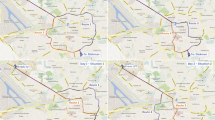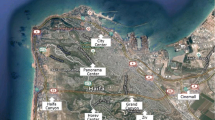Abstract
The decisions drivers make, such as choice of route or departure time, constitute typical decision making under uncertainty. Drivers' decision making has been studied within the framework of expected utility theory. However, empirical decisional phenomena violating the premise of expected utility theory have been observed repeatedly. These findings have indicated that decision making is critically affected by the decision frame. It has also been pointed out that the uncertainty of outcome is perceived as an interval of possible resultant values. Based on these findings, we propose hypotheses that: (1) a driver perceives an uncertain travel time as an interval, and (2) a driver decides on a departure time based on a decision frame edited by this interval. To test these hypotheses, we collected data on drivers' departure time choice behavior, n = 335. Decisional phenomena found in this study confirm our hypotheses.
Similar content being viewed by others
References
Akiyama, T., K. Nakamura, and T. Sasaki, (1993). "Traffic Diversion Model on Urban Expressway by Fuzzy Reasoning." In Selected Proceedings of the Sixth World Conference of Transportation Research, pp. 1011–1022.
Allais, M. (1953). "Le Comportement de l'homme Rationnel Devant le Risque, Critique Despostulates et axiomes de l'école Américaine." Econometrica21, 503–546.
Beyth-Marom, R. (1982). "How Probable is Probable?: Numerical Translation of Verbal Probability Expressions." Journal of Forecasting1, 267–279.
Bonsall, P.W. and H.J. Cho. (1999). "Travelers Response to Uncertainty, the Particular Case of Drivers' Response to Imprecisely Known Tolls and Charges." In Proceedings of European Transport Conference, University of Cambridge, PTRC, London, pp. 63–73.
Chang, G.L. and H.S. Mahmassani. (1988). "Travel Time Prediction and Departure Time Adjustment Behavior Dynamics in a Congested Traffic System." Transportation Research B22B(3), 217–232.
Dawes, R.M. (1997). "Behavioral Decision Making, Judgement, and Inference." In D. Gilbert, S. Fiske, and Lindsey (eds.), The Handbook of Social Psychology(4th edition). Boston: McGraw-Hill, pp. 498–566.
Dial, R.B. (1971). "A Probabilistic Multipath Traffic Assignment Model Which Obviates Path Enumeration." Transportation Research5, 83–111.
Doherty, S.T., K.W. Axhausen, T. Gärling, and E.J. Miller. (1998). "A Conceptual Model of the Weekly Household Activity-Travel Scheduling Process." Paper presented at the Network on European Communications and Transport Activities Research Euroconference, Israel.
Eliahu, M. and J.M. Guttman. (1986). "Uncertainty, Continuos Modal Split, and the Value of Travel Time in Israel." Journal of Transport Economics and Policy20(3), 369–375.
Ellsberg, D. (1961). "Risk, Ambiguity, and the Savage Axioms." Quarterly Journal of Economics. 75, 643–669.
Fujii, S. and R. Kitamura. (2000). "Anticipated Travel Time, Information Acquisition and Actual Experience: The Case of Hanshin Expressway Route Closure." Transportation Research Record1725, 79–85.
Fujii, S., T. Morita, R. Kitamura, and M. Sugiyama. (1999). "An Empirical Analysis of the Heterogeneity in Attitudes Toward Uncertainty and Development of a Route-Choice Model for Demand Forecasting." Infrastructure Planning Review16, 569–576 (in Japanese with English abstract).
Fujii, S. and K. Takemura. (2000). "Attention and Risk Attitude: Contingent Focus Model of Decision Framing." International Journal of Psychology35(3/4), 269.
Gärling, T. (1998). "Behavioral Assumptions Overlooked in Travel-Choice Modeling." In J. Ortuzar, S. Jara-Diaz, and D. Hensher (eds.), Transport Modeling. Oxford: Pergamon, pp. 3–18.
Groves, R.M. (1989). Survey Errors and Survey Costs. New York: Willey.
Hogarth, R.M. (1987). Judgement and Choice: The Psychology of Decision. John Wiley & Sons.
Henn, V. (2000). "Fuzzy Route Choice Model for Traffic Assignment." Fuzzy Sets and Systems116(1), 77–101.
Iida, Y., T. Akiyama, and T. Uchida. (1992). "Experimental Analysis of Dynamic Route Choice Behavior." Transportation Research B26B(1), 17–32.
Kahneman, D. and A. Tversky. (1979). "Prospect Theory: An Analysis of Decision Under Risk." Econometrica47, 263–291.
Kikuchi S. and van Zulyen, H. (2003). "Modeling of Travelers' Uncertainty and Anxiety." In M.G.H. Bell and Y. Iida (eds.), The Network Reliability of Transport. Amsterdam: Pergamon, pp. 133–154.
Kühberger,A. (1998). "The Influence of Framing on Risky Decisions:AMeta-Analysis." Organizational Behavior and Human Decision Processes75(1), 23–55.
Maher, M. (1998). "Algorithms for Logit-Based Stochastic User Equilibrium Assignment." Transport Research B32B(8), 539–549.
Maher,M. and X. Zhang. (1999). "Route Choice to Maximize the Probability of ArrivalWithin a Specified Time." Paper presented at Transport Network Reliability Workshop, Newcastle, UK.
McNeil, B.J., S.G. Pauker, H.C. Sox, and A. Tversky. (1982). "On the Elicitation of Preference for Alternative Therapies. New England Journal of Medicine27, 1259–1262.
Menashe, E. and J.M. Guttman. (1986). "Uncertainty, Continuous Modal Split, and the Value of Travel Time in Israel." Journal of Transport Economics and Policy20(3), 369–375.
Noland, R.B. and K.A. Small. (1995). "Travel-Time Uncertainty, Departure Time Choice, and the Cost of Morning Commutes." Transportation Research Record1493, 150–158.
Polak, J. and F. Oladeinde. (1999). "An Empirical Model of Travelers' Day-to-Day Learning in the Presence of Uncertain Travel Time." Paper presented at Transport Network Reliability Workshop, Newcastle, UK.
Savage, I.R. (1954). The Foundations of Statistics. New York: Wiley.
Selart, M., O. Boe, and T. Gärling. (1999). "Reasoning About Outcome Probabilities and Values in Preference Reversals." Thinking and Reasoning5(2), 175–188.
Simon, H.A (1990). "Invariants of Human Behavior." Annual Review of Psychology41(1), 1–19.
Slovic, P. (1995). "The Construction of Preferences." American Psychologist50, 364–371.
Slovic, P., D. Griffin, and A. Tversky. (1990). "Compatibility Effects in Judgement and Choice." In R.M. Hogarth (ed.), Insights in Decision Making. Chicago: University of Chicago Press, pp. 5–27.
Slovic, P. and S. Lichtenstein. (1983). "Preference Reversal: A Broader Perspective." American Economic Review73, 623–638.
Slovic, P. and A. Tversky. (1974). "Who Accepts Savage's axiom?" Behavioral Science19, 368–373.
Teodorovic, D. (1999). "Fuzzy Logic Systems forTransportation Engineering: The State of the Art." Transportation Research Part A: Policy and Practice33(5), 337–364.
Teodorovic, D. and S. Kikuchi. (1990). "Transportation Route Choice Model Using Fuzzy Inference Technique." In B.M. Ayyub (ed.), Proceedings of ISUMA 90', The First International Symposium on Uncertainty Modeling and Analysis, College Park, MD: IEEE Computer Press, pp. 140–145.
Tversky, A. and D. Kahneman. (1981). "The Framing of Decisions and the Psychology of Choice." Science211, 453–458.
Tversky, A. and D. Kahneman. (1992). "Advances in Prospect Theory: Cumulative Representation of Uncertainty." Journal of Risk and Uncertainty5, 297–323.
Tversky, A., P. Slovic, and D. Kahneman. (1990). "The Causes of Preference Reversal." American Economic Review80, 204–217.
Von Neumann, J. and O. Morgenstern. (1944). Theory of Games and Economic Behavior. Princeton: Princeton University Press.
Walley, P. (1991). Statistical Reasoning with Imprecise Probability. London: Chapman and Hall.
Yamamoto, T., S. Fujii, and R. Kitamura. (2000). "An Analysis of Departure Time and Route Choice Behavior Under Congestion Pricing Using Stated Preference Data." Transportation Research Record1725, 95–101.
Zadeh, L.A. (1965). "Fuzzy Sets." Information and Control8, 338–353.
Rights and permissions
About this article
Cite this article
Fujii, S., Kitamura, R. Drivers' Mental Representation of Travel Time and Departure Time Choice in Uncertain Traffic Network Conditions. Networks and Spatial Economics 4, 243–256 (2004). https://doi.org/10.1023/B:NETS.0000039781.10517.3a
Issue Date:
DOI: https://doi.org/10.1023/B:NETS.0000039781.10517.3a




